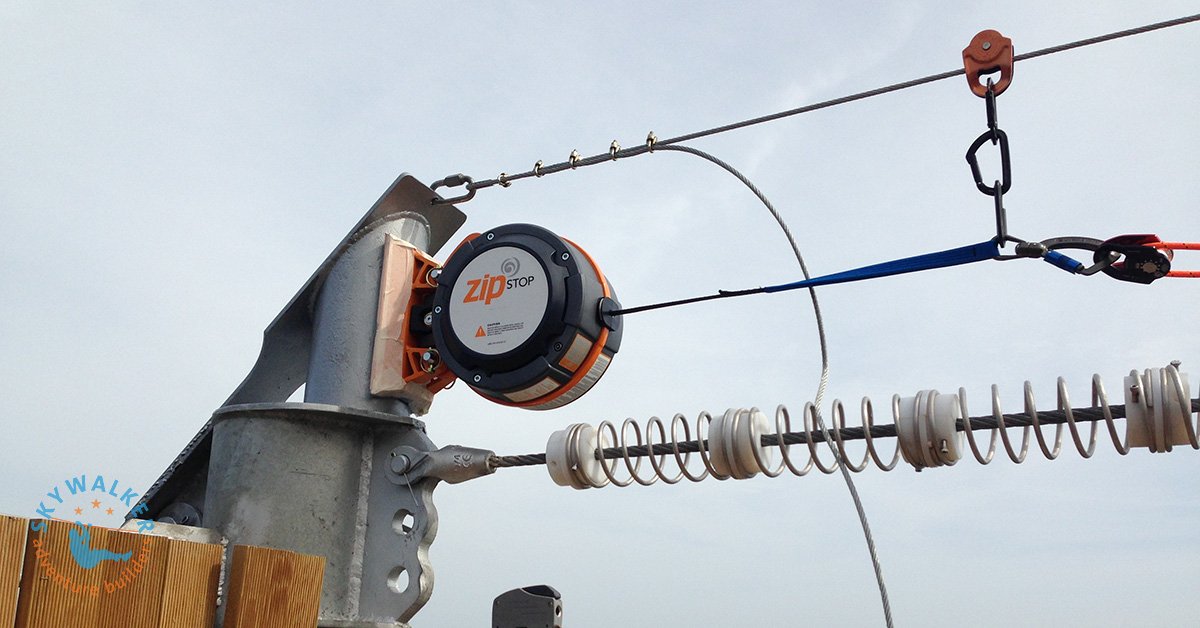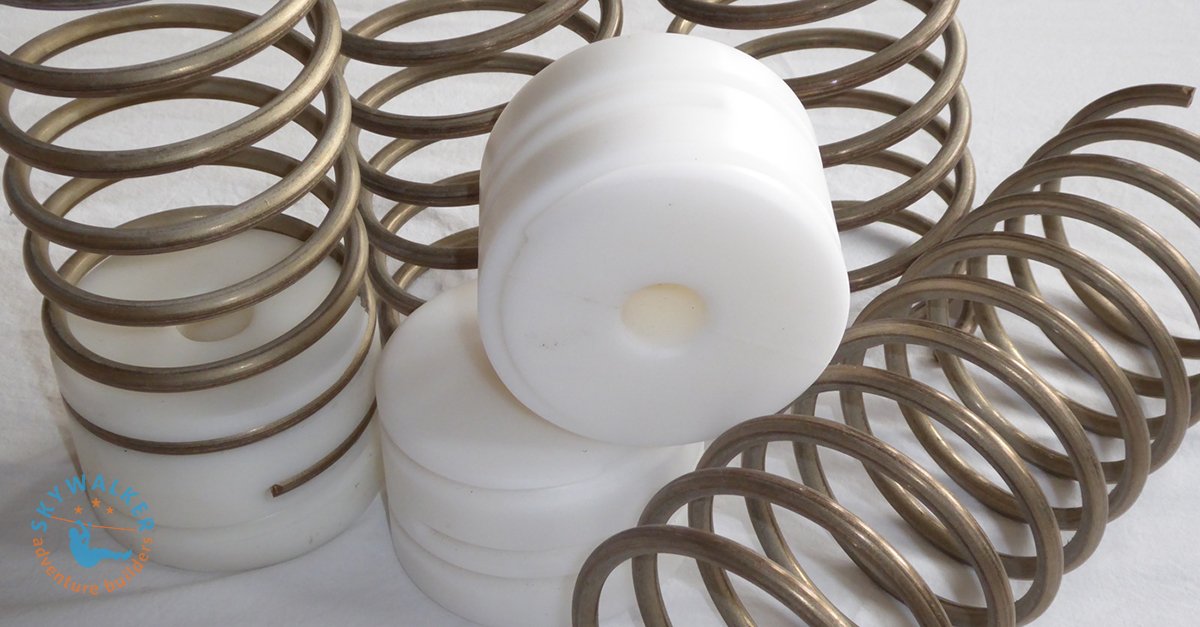For adventure park operators focused on delivering thrilling yet safe zipline experiences, the braking system is paramount. Among the various options available, the zipline spring brake stands out as a robust and reliable solution for both primary deceleration and emergency arrest. Engineered to handle high speeds and significant impacts, these systems offer a cost-effective and low-maintenance approach to ensuring rider safety and optimizing operational efficiency.
Understanding the Mechanics and Applications of Zipline Spring Brakes
Zipline spring brakes are designed with a straightforward yet effective principle. Upon impact from a rider, the large metal coils of the brake compress, efficiently absorbing the kinetic energy and bringing the participant to a controlled stop. These systems can be implemented in two key ways, offering versatility for various zipline configurations.
- As a primary brake with a 2:1 reduction, the spring brake not only decelerates riders but also functions as an Emergency Arrest Device (EAD) in the event of a primary system failure.
- As a standalone EAD, the zipline spring brake can be integrated with virtually any other primary braking system, providing an essential layer of redundancy for enhanced safety.
This dual functionality makes the zipline spring brake a valuable asset for operators seeking to maximize safety without compromising the thrill of the ride.
Key Advantages of Implementing Zipline Spring Brake Systems
The adoption of zipline spring brakes offers several compelling benefits for professional operators. These advantages contribute to both the safety and the efficiency of zipline operations, directly impacting visitor satisfaction and profitability.
- Proven Reliability: With a track record of handling hundreds of thousands of impacts, these systems demonstrate their durability and consistent performance in high-use environments.
- Cost-Effectiveness: Especially when paired with other braking solutions like a Zipstop, the zipline spring brake serves as an economical EAD that is rarely activated, preserving its lifespan.
- Minimized Operator Error: When installed in series along the cable, the risk of operator-related failures during peak operational times is significantly reduced.
- Efficient Rider Management: As a primary brake, the system allows for quick unloading of riders and trolleys, followed by rapid resetting, contributing to improved throughput.
- Low Maintenance: Featuring spacers designed for excellent wear properties and low friction, and being pre-stressed for extended life, these brakes require minimal upkeep, reducing operational costs and downtime.
These advantages underscore the value proposition of zipline spring brakes for professional adventure operations.
Considerations for Optimal Zipline Spring Brake Integration
While zipline spring brakes offer numerous benefits, operators should also be aware of certain considerations to ensure optimal performance and customer experience. Addressing these factors proactively will lead to smoother and safer operations.
- Space Requirements: Unlike some braking systems that move along the cable, spring brakes are typically installed permanently, necessitating adequate platform space or dedicated terminal structures.
- Variable Braking Experience: Rider weight and environmental conditions such as wind and cable wetness can influence the final braking experience. Heavier riders may experience more compression and rebound, while lighter riders might have a more abrupt stop.
- Throughput Implications: The slight rebound effect inherent in spring brake operation can add a few seconds to the overall rider processing time, potentially impacting throughput during high-volume periods.
Careful consideration of these factors during the design and installation phase will help mitigate potential drawbacks.
Spring Brakes as Essential Emergency Arrest Devices (EADs)
Beyond their utility as primary brakes, zipline spring brakes are exceptionally effective as Emergency Arrest Devices (EADs). Industry standards often mandate the inclusion of a passive, independent EAD on ziplines exceeding certain speeds. Spring packs, consisting of multiple springs connected by durable spacer blocks, are a versatile solution for this critical safety requirement.
- The number of springs in a pack can be adjusted based on specific operational parameters, including rider arrival speed, weight range, and the type of primary brake in use.
- Properly engineered and installed spring packs create a robust fail-safe braking system, providing an essential backup to prevent serious incidents in case of primary brake failure.
- Regular inspection and maintenance, particularly regarding corrosion and padding condition, are crucial to ensure the continued reliability of spring brake EADs.
Consulting with zipline experts to ensure correct design and installation according to relevant safety guidelines is paramount when utilizing spring brakes as EADs.
Understanding Zipline Spring Brakes
In conclusion, zipline spring brakes represent a vital component for professional adventure, outdoor, amusement, and recreation operators. Their proven ability to function effectively as both primary and secondary braking systems, coupled with their reliability and low maintenance requirements, makes them a sound investment for enhancing safety and operational efficiency. While considerations such as space and variable braking experiences exist, the overall advantages of incorporating zipline spring brake technology into zipline courses are significant, contributing to smoother operations, increased rider confidence, and ultimately, a more successful and sustainable business.
What are the primary functions of a zipline spring brake?
Zipline spring brakes are primarily used to decelerate riders at the end of a zipline run and can also serve as an Emergency Arrest Device (EAD) to stop riders in the event of a primary braking system failure.
What makes zipline spring brakes a reliable choice for high-speed ziplines?
Engineered for high speeds and significant impacts, zipline spring brakes have a proven track record, often withstanding hundreds of thousands of hits while maintaining their effectiveness and requiring minimal maintenance.
How does a zipline spring brake contribute to operational efficiency?
As a primary brake, zipline spring brakes allow for quick unloading and resetting, which helps to streamline the rider flow and maximize throughput, especially during high-capacity days.
What are the key maintenance requirements for zipline spring brake systems?
Zipline spring brakes are designed for low maintenance, primarily requiring regular inspections to check for corrosion and the condition of any padding. Their pre-stressed nature also contributes to a longer, low-maintenance lifespan.
Can zipline spring brakes be used in conjunction with other braking systems?
Yes, zipline spring brakes are highly versatile and can be effectively used as a standalone EAD in conjunction with almost any other primary braking system, providing an added layer of safety and redundancy.
Planning a zipline installation? Need expert advice on zipline design?
Get started Today
Additional expert Information regarding Zipline technology
Interested to read more about Zipline technology and expert opinions?
- The Power of Zip Line Simulation Software
- Bi-Directional Zip Line Technology
- Zip Line Design: Components for a Complete System
- How a Zipline Feasibility Study Guarantees Success
- MAG Brake Trolley, the Magnetic Self-braking Zipline pulley
- Professional Zipline Engineering & Design services
- How to Launch a Zip Line Company
- The Science of Zipline Design and Engineering
- Zipline Mistakes You Don’t Know You’re Making
- Key elements: Zipline Design and Engineering
- Thinking of investing and operating a Zipline?
- Zipline Emergency Arrest Devices (EADs)
- The ZipCoaster - Fly through the air, dipping and twisting
- Pros and Cons of Different Zip Line Brakes
- Expert Tips for Zip Line Brake Installations
- Thinking of investing and operating a Zipline?
- Ingenious inventions. The curvy zip line














